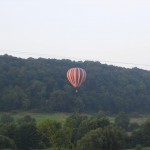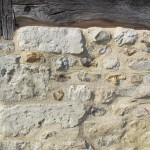The origin of the names “Pays d’Auge” and Blangy le Château.
It has long sought the origin of the name “Pays d’Auge”; The oldest name of our region was Saltus Algie – forest Auge. Saltus means “wooded and mountainous region, interspersed with ravines, well suited for pastures.” As for Algie, the word comes from a common name of Germanic origin that means: “Pasture bathed in a stream.”

Forêt sur le sommet des collines de Blangy le Château
Our country is forested, hilly, intersected by ravines, well suited for pastures and bathed in countless streams.
Since Gallo-Roman times, the village was just called Blangy. It was not until the 19th century, and at the request of City Council, a ministerial decree authorized the designation of Blangy-le-Château, so it would not be confused with Blangy-sur-Bresle in Seine Maritime. The confusion between the two municipalities had caused some errors in the delivery of mail when the postal service was organized.

Pierre blanche et silex du soubassement d’une maison de Blangy le Château
Blangy comes from Blan, a celtic word meaning : white, soft, dull or bland, and Gy or Geium, Latin term which means Earth. Presumably Blangy means: white earth, because of Blangy’s hilly limestone foundations.
Limestone has always been exploited in Blangy. On the territory of the municipality, there is a cavity at the bottom of which (about 7 meters) there are stones that were extracted, worked upon and destined for construction. How long have they been waiting?
Nobody knows …
They also manufactured lime. One can find lime kilns in the northeast, along the Little Forest, and also near Mount Brou. On the slopes of Mount Brou are open caves that were used by the people of Blangy who sought refuge during the arrival of the Allies in 1944. In the limestone bedrock of Mount Brou, during a school survey, the children discovered traces of iron.
Water is very present in Blangy due to the limestone base springs flowing from its seven hills. Blangy, like Rome or Paris, developed within the protection of its seven hills, even influencing such things as the name of our school, The School of the Seven Hills.
Two rivers run through Blangy: the Douet-Hebert and the Chaussey, other names that are evocative of water in the village are: Pissing Hill, Path of the Fountains, The Old Washhouse Street, The Bourgerue Path, a deformation of “stream of the town”. There is even a water mill down the street from the church at the edge of Chaussey.
Today to help you along the way I’ll be a real chatterbox!





 Krea3
Krea3


